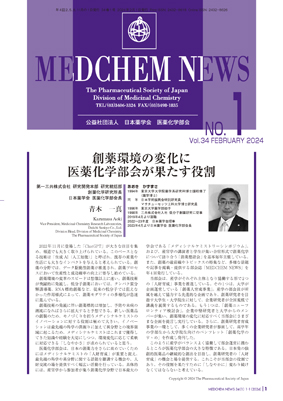Current issue
Displaying 1-18 of 18 articles from this issue
- |<
- <
- 1
- >
- >|
-
2024 Volume 34 Issue 1 Pages 1
Published: February 01, 2024
Released on J-STAGE: February 01, 2024
Download PDF (620K)
-
2024 Volume 34 Issue 1 Pages 7-11
Published: February 01, 2024
Released on J-STAGE: February 01, 2024
Download PDF (965K)
WINDOW
-
2024 Volume 34 Issue 1 Pages 12-16
Published: February 01, 2024
Released on J-STAGE: February 01, 2024
Download PDF (808K)
ESSAY
-
2024 Volume 34 Issue 1 Pages 17-19
Published: February 01, 2024
Released on J-STAGE: February 01, 2024
Download PDF (808K) -
2024 Volume 34 Issue 1 Pages 20-24
Published: February 01, 2024
Released on J-STAGE: February 01, 2024
Download PDF (1926K) -
2024 Volume 34 Issue 1 Pages 25-29
Published: February 01, 2024
Released on J-STAGE: February 01, 2024
Download PDF (1096K) -
2024 Volume 34 Issue 1 Pages 30-35
Published: February 01, 2024
Released on J-STAGE: February 01, 2024
Download PDF (1464K) -
2024 Volume 34 Issue 1 Pages 36-42
Published: February 01, 2024
Released on J-STAGE: February 01, 2024
Download PDF (2929K)
DISCOVERY
-
2024 Volume 34 Issue 1 Pages 43-46
Published: February 01, 2024
Released on J-STAGE: February 01, 2024
Download PDF (918K)
Coffee Break
-
2024 Volume 34 Issue 1 Pages 47
Published: February 01, 2024
Released on J-STAGE: February 01, 2024
Download PDF (746K)
REPORT
-
2024 Volume 34 Issue 1 Pages 48-50
Published: February 01, 2024
Released on J-STAGE: February 01, 2024
Download PDF (1453K)
-
2024 Volume 34 Issue 1 Pages 19
Published: February 01, 2024
Released on J-STAGE: February 01, 2024
Download PDF (614K)
BOOKS
-
2024 Volume 34 Issue 1 Pages 35
Published: February 01, 2024
Released on J-STAGE: February 01, 2024
Download PDF (671K)
-
2024 Volume 34 Issue 1 Pages 51
Published: February 01, 2024
Released on J-STAGE: February 01, 2024
Download PDF (514K) -
2024 Volume 34 Issue 1 Pages 52-53
Published: February 01, 2024
Released on J-STAGE: February 01, 2024
Download PDF (1592K) -
2024 Volume 34 Issue 1 Pages 53
Published: February 01, 2024
Released on J-STAGE: February 01, 2024
Download PDF (926K) -
2024 Volume 34 Issue 1 Pages 54
Published: February 01, 2024
Released on J-STAGE: February 01, 2024
Download PDF (538K)
-
2024 Volume 34 Issue 1 Pages 56
Published: February 01, 2024
Released on J-STAGE: February 01, 2024
Download PDF (654K)
- |<
- <
- 1
- >
- >|
